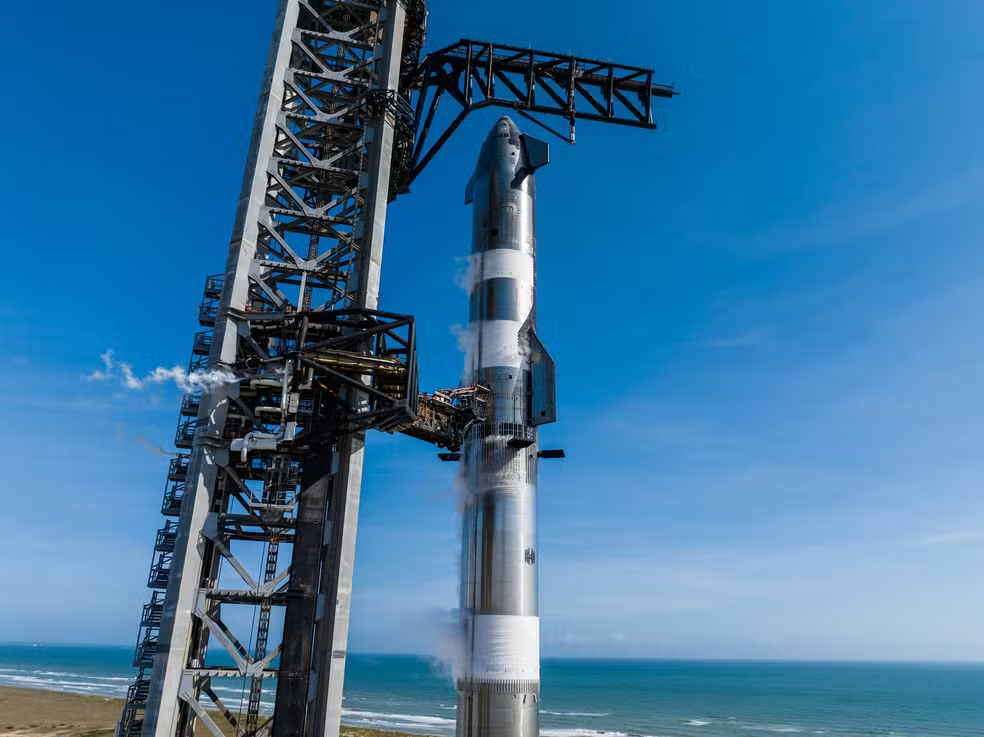The development of space rockets has historically reflected the technological, scientific, and cultural advancement of humanity. In this context, SpaceX’s Starship holds a unique position—not only as the largest and most powerful rocket ever built but also as a symbol of the ambition to make space exploration accessible and continuous. Its goal goes beyond breaking technical records: Starship was designed to enable Mars colonization missions, large-scale cargo transport, interplanetary travel, and even revolutionize long-distance terrestrial transportation, allowing global trips in minutes.
Standing at an impressive 122 meters tall, Starship is taller than the Statue of Liberty (including its pedestal) and generates a staggering 7,590 tons of thrust at launch—the equivalent of about 50 fully loaded Boeing 747 aircraft. This level of power is unprecedented in aerospace history, surpassing all other rockets ever built by a significant margin.

Its design is also a milestone of innovation. Developed to be fully reusable, Starship aims to eliminate the exorbitant costs associated with conventional space launches. The system consists of two main parts: the Super Heavy, a booster rocket that provides the initial thrust to escape Earth’s gravity, and the Starship itself, which can operate in space and land in a controlled manner on any planet or surface.
To grasp the magnitude of SpaceX’s achievement, it is useful to compare it to the largest rockets in the history of space exploration, each responsible for significant advancements in its era.
Falcon Heavy
Also created by SpaceX, Falcon Heavy was, until Starship’s arrival, the most powerful operational rocket in the world. At 70 meters tall and generating 2,268 tons of thrust at launch, it can place large payloads into Earth orbit or conduct deep-space missions. However, its power is only one-third of SpaceX’s new colossus, demonstrating the immense technological leap achieved in less than a decade.
Saturn V
Perhaps the most iconic rocket in history, Saturn V was the backbone of the Apollo missions that sent humans to the Moon between 1969 and 1972. Standing at 110 meters tall and producing 3,448 tons of thrust at launch, it held the title of the most powerful rocket for over 50 years. Despite its historical impact, Saturn V’s thrust is less than half that of Starship, highlighting the exponential progress of modern space engineering.
Space Shuttle
After the Apollo missions, NASA introduced the Space Shuttle, a versatile and partially reusable launch system. At 55 meters tall, it used two solid-fuel boosters that together generated 2,404 tons of thrust at launch. While it revolutionized space exploration with its ability to transport crews and cargo repeatedly, its power falls far short of Starship’s capabilities.
Space Launch System (SLS)
SLS, NASA’s new rocket designed to take astronauts back to the Moon under the Artemis program, is currently the most powerful operational rocket. It produces 3,992 tons of thrust—just over half of Starship’s power. At 65 meters tall, SLS is an ambitious project, but its capabilities still do not compare to what Starship promises, both in reusability and payload capacity.
N1, the Soviet Mega Rocket
During the space race, the Soviet Union developed the N1, intended as their response to Saturn V and to enable lunar missions. Although designed to generate 4,536 tons of thrust—about 40% less than Starship—the N1 never became operational, failing in all four launch attempts. Elon Musk, founder of SpaceX, has stated that the N1 was an inspiration for Starship’s modular and ambitious design, showing how past lessons have shaped present innovations.
Starship is not just the largest and most powerful rocket ever built—it is a bold bet on the possibility of transforming humanity into a multiplanetary species. SpaceX plans to use it to colonize Mars, transporting large groups of people, tons of cargo, and enough infrastructure to build permanent bases on the Red Planet.
Furthermore, the system could play crucial roles in other scenarios, such as lunar missions, deploying giant telescopes into deep space, rapidly delivering supplies during global crises, and even revolutionizing intercontinental travel on Earth. With Starship, a trip from New York to Tokyo could take less than an hour.
The arrival of Starship marks a new era in space exploration, defined by goals once considered unattainable. By combining impressive dimensions, unmatched power, and an economic approach, it redefines what is possible in the cosmos.
If it reaches its full potential, Starship could not only take humanity to Mars but also establish SpaceX as the absolute leader in future space exploration, breaking the barriers that have confined us to Earth’s orbit for decades. The sky—or rather, the universe—is the limit for Starship.
Starship is not just a rocket; it is a statement of intent: humanity is ready to expand its horizons beyond Earth. With its unprecedented power, colossal size, and reusable design, Starship redefines the boundaries of space exploration, turning once-distant dreams—like Mars colonization and interplanetary travel—into tangible goals.
More than an engineering feat, Starship symbolizes a moment of convergence between technological innovation and strategic vision. It inspires not only scientists and engineers but all of humanity, reminding us that progress is possible when we dream big and work hard to turn those dreams into reality.
As Starship’s first operational flight approaches, the world watches with anticipation, aware that each successful launch is another step toward a new era. If SpaceX succeeds, Starship will not just be a milestone in the present—it will be the foundation upon which the future of space exploration is built. The universe, vast and full of possibilities, has never been so within reach.

